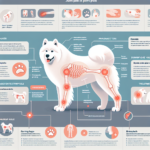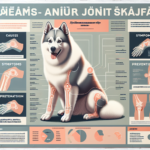Samoyed Joint Pain: Causes, Symptoms, Prevention, and Treatment

Introduction
The Samoyed, often referred to as the “Smiling Sammie,” is a breed known for its friendly disposition, striking white coat, and history as a working dog. Originating from Siberia, these dogs were initially bred by the Samoyede people for herding reindeer, pulling sleds, and keeping their owners warm in the harsh Arctic climate. Their thick, double-layered coat and robust build make them well-suited for cold environments, while their gentle and playful nature has made them popular family pets.
Despite their hardy appearance, Samoyeds are prone to several health issues, with joint pain being a significant concern. This article will delve into the causes, symptoms, prevention, and treatment of joint pain in Samoyeds, providing a comprehensive guide for owners to ensure their pets lead healthy, active lives.
Breed-Specific Joint Pain Risks
Genetic Predisposition
Samoyeds, like many other large breeds, are genetically predisposed to joint-related issues. Hip dysplasia, a condition where the hip joint doesn’t fit properly into the hip socket, is particularly common. This genetic disorder can lead to arthritis and significant pain if not managed appropriately. Elbow dysplasia, another hereditary condition, affects the elbow joints and can cause lameness and discomfort.
Age-Related Risks
As Samoyeds age, the risk of developing joint pain increases. While younger dogs may show early signs of joint issues, such as mild limping or stiffness, these symptoms often become more pronounced as the dog reaches middle age (around 5-7 years) and senior years (8 years and older). Regular veterinary check-ups are crucial during these stages to monitor joint health and catch any issues early.
Activity Level and Joint Stress
Samoyeds are known for their high energy levels and love for physical activities. Whether they are running, playing, or pulling sleds, their joints are constantly under stress. While exercise is essential for their overall health, excessive or inappropriate activities can exacerbate joint problems. Owners should be mindful of the types and intensity of exercises their Samoyeds engage in to prevent undue joint stress.
Common Symptoms of Joint Pain in Samoyeds
General Symptoms
Owners should be vigilant for common signs of joint pain in their Samoyeds, including:
- Limping or favoring one leg
- Stiffness, especially after rest or sleep
- Reluctance to climb stairs or jump
- Decreased activity or playfulness
- Visible discomfort or pain when touched
- Swelling around the joints
Breed-Specific Symptoms
In Samoyeds, joint pain may also manifest as a reluctance to engage in activities they previously enjoyed, such as pulling sleds or running. Their thick coat can sometimes mask swelling, so owners should pay close attention to changes in behavior and movement.
When to Consult a Vet
If any of the above symptoms are observed, it is essential to consult a veterinarian promptly. Early diagnosis and intervention can significantly improve the quality of life for a Samoyed suffering from joint pain. Regular veterinary check-ups are also recommended to monitor joint health and catch any issues early.
Preventive Measures for Joint Health
Exercise Recommendations
Regular, moderate exercise is crucial for maintaining joint health in Samoyeds. Activities such as walking, swimming, and controlled play can help keep their joints flexible and muscles strong. Avoid high-impact activities like jumping or running on hard surfaces, which can exacerbate joint stress. Tailoring exercise routines to the dog’s age and physical condition is essential for preventing joint issues.
Dietary Suggestions
A balanced diet rich in essential nutrients can support joint health. Foods containing glucosamine, chondroitin, and omega-3 fatty acids are particularly beneficial. These nutrients help maintain cartilage health and reduce inflammation. Owners may also consider joint supplements, but it is advisable to consult a veterinarian before adding any supplements to the dog’s diet.
Weight Management
Maintaining a healthy weight is crucial for reducing joint stress. Excess weight can put additional pressure on the joints, exacerbating pain and discomfort. Owners should monitor their Samoyed’s weight and adjust their diet and exercise routine as needed to prevent obesity. Regular weigh-ins and body condition assessments can help keep the dog at an optimal weight.
Early Screening and Monitoring
Early screening for joint issues can help catch problems before they become severe. Regular veterinary check-ups, including X-rays and physical examinations, can identify early signs of joint dysplasia or arthritis. Genetic testing may also be available to determine the risk of hereditary joint conditions. Early intervention can significantly improve the prognosis for dogs with joint issues.
Treatment Options for Joint Pain
Non-Surgical Treatments
Non-surgical treatments for joint pain in Samoyeds include:
- Medications: Anti-inflammatory drugs and pain relievers can help manage pain and reduce inflammation.
- Physical Therapy: Exercises and therapies designed to improve joint mobility and strengthen muscles can be beneficial.
- Lifestyle Adjustments: Modifying the dog’s activity level and providing a comfortable living environment can help manage symptoms.
Surgical Options
In severe cases, surgical intervention may be necessary. Common surgical options include:
- Hip Replacement: Replacing the damaged hip joint with an artificial one can significantly improve mobility and reduce pain.
- Arthroscopy: A minimally invasive procedure to clean out the joint and remove damaged tissue.
- Osteotomy: Cutting and realigning bones to improve joint function.
Surgical options should be discussed with a veterinarian to determine the best course of action for the individual dog.
Alternative Therapies
Alternative therapies can complement traditional treatments and provide additional relief. These may include:
- Acupuncture: Using needles to stimulate specific points on the body to relieve pain and improve joint function.
- Hydrotherapy: Water-based exercises that reduce joint stress while improving mobility and strength.
- Massage: Gentle massage can help reduce muscle tension and improve circulation around the joints.
Lifestyle and Management Tips
Daily Care Routine
A daily care routine for a Samoyed with joint pain might include:
- Gentle morning walks to loosen stiff joints
- Administering prescribed medications or supplements
- Providing a balanced diet with joint-supporting nutrients
- Engaging in low-impact activities like swimming or controlled play
- Regular physical therapy sessions if recommended by a vet
Modifying the Home Environment
Making the home environment more comfortable for a dog with joint pain can significantly improve their quality of life. Consider the following modifications:
- Installing ramps to help the dog navigate stairs
- Providing orthopedic beds for better joint support
- Ensuring food and water bowls are at a comfortable height
- Using non-slip mats to prevent falls on slippery surfaces
Long-Term Management
Long-term management of joint pain involves regular monitoring and adjustments to the dog’s care routine. This may include:
- Regular veterinary check-ups to monitor joint health
- Adjusting exercise routines as the dog’s condition changes
- Continuing with prescribed medications or supplements
- Providing ongoing physical therapy or alternative treatments
Maintaining a positive and supportive environment is crucial for keeping the dog active and happy despite joint pain.
FAQs About Samoyeds and Joint Pain
What are the early signs of joint pain in Samoyeds?
Early signs of joint pain in Samoyeds include limping, stiffness, reluctance to move, and decreased activity levels. Owners should watch for these symptoms and consult a veterinarian if they are observed.
Can joint pain in Samoyeds be prevented?
While genetic predispositions cannot be entirely prevented, maintaining a healthy weight, providing a balanced diet, and ensuring regular, moderate exercise can help reduce the risk of joint pain. Early screening and monitoring are also crucial for catching issues early.
Are there specific exercises that are better for Samoyeds with joint pain?
Low-impact exercises such as walking, swimming, and controlled play are ideal for Samoyeds with joint pain. These activities help maintain joint mobility and muscle strength without putting excessive stress on the joints.
What dietary supplements can help with joint health in Samoyeds?
Supplements containing glucosamine, chondroitin, and omega-3 fatty acids can support joint health. These nutrients help maintain cartilage health and reduce inflammation. Always consult a veterinarian before adding supplements to the dog’s diet.
When should I consider surgery for my Samoyed’s joint pain?
Surgery should be considered if non-surgical treatments are not effective and the dog’s quality of life is significantly impacted by joint pain. A veterinarian can provide guidance on the best surgical options based on the dog’s specific condition.
Conclusion
Joint pain is a common concern for Samoyeds, but with proper care and attention, it can be managed effectively. By understanding the causes, symptoms, prevention, and treatment options, owners can ensure their Samoyeds lead healthy, active lives. Regular veterinary check-ups, a balanced diet, appropriate exercise, and early intervention are key to maintaining joint health. By taking these preventive measures and consulting with a veterinarian regularly, owners can help their Samoyeds enjoy a happy and pain-free life.



